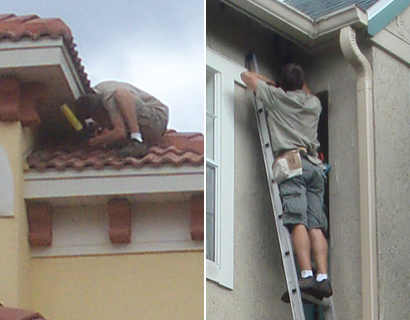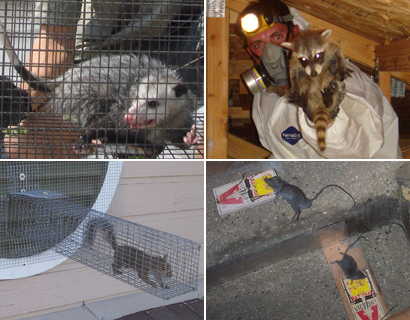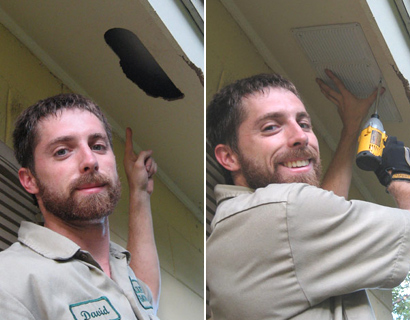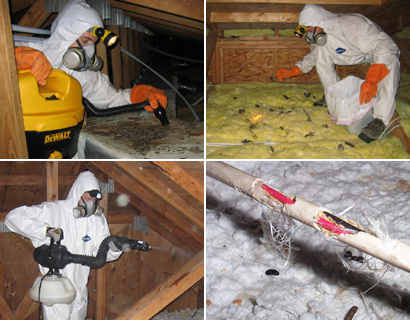- How We Solve California Wildlife Problems
How We Solve Long Beach Wildlife Problems
INSPECTION: Once on site, we will perform a full inspection of your home and property. This allows us to use the correct strategy and traps. If the animals are in an attic, a full building inspection is crucial, including the following:
- All ground-level areas, such as piper or A/C line entry & exit areas, A/C chase bottoms, ground-level vents, etc.
- All mid-level areas, such as dryer vents, siding gaps, first floor eaves or dormers, etc.
- We inspect the entire roof, including all plumbing stacks, ridge caps, vents, and other potential gaps or holes.
- We also inspect inside your attic, to identify animals and damage they have caused.
- If the animals are outside, we notice many subtle clues that will assist us in a successful strategy.
TRAPPING, EXCLUSION, REMOVAL: Once we understand what animal species we are dealing with, and the problem, we use the most effective means of removing the animals. We use dozens of different types of traps.
- Trapping - If trapping the animal(s) in live cage traps, trap type, set, and location are crucial to success.
- Exclusion - Oftentimes, we are able to simply set one-way doors or other exclusion devices that allow the animals inside a building to safely exit, but never get back inside.
- Removal By Hand - Sometimes we actually remove animals by hand, or with special tools like snare poles.
- The Law - In all cases, we obey state and local laws regarding wildlife, but aim to take the most humane approach.
ENTRY HOLE REPAIRS: Repairs are a crucial step in the wildlife removal process. In many cases, such as bat or rodent control, the job cannot be performed without detailed repairs, and in all cases, sealing the entry holes shut ensures that no future wildlife will ever enter your home.
- 100% of the entry holes must be found, and sealed shut, or the job is not complete.
- Our repairs are professional contractor grade, look good, and when applicable we use steel, which rodents such as rats or squirrels are unable to chew through.
- We give a written guarantee on our repairs against any future animal entry.
ATTIC DECONTAMINATION SERVICES: It may be desirable to clean your attic after we've removed the animals. They can leave behind large amounts of droppings, urine, hair, oils, food, nesting material, and so on. These remnants can attract insects like cockroaches, and the scent left behind can encourage new animals to chew their way into your house. You might experience odor problems from the waste. It's possible that mold will grow on waste areas.
- We remove or vacuum all droppings, or remove all the soiled insulation.
- We fog the attic with a special enzyme-based cleaner that destroys any organic matter and deodorizes the space.
- We repair damage, such as ductwork, electrical wires, pipes, insulation, and more.
Hello! Welcome! We're the #1 wildlife removal and control company in the metropolitan area, and not just for one year - three years on the trot! Why? Because we're great at what we do - we've got ten years of experience to back our family-run business, and we use only the very best and state-of-the-art tools and equipment to help get those wild animals out, and keep them out. We do things in a really humane way too - no poisons ever used here. We like to do things the safe and humane way, using exclusion devices and methods to get those animals out, and then sealing up the holes so that they can't get back in again. Our 32-point inspection service will soon point out those big gaps that you're not seeing, but we can fix all of that for you. We'll also sort out any damage that the wild animal will have left behind too - chewing wiring, dug-out lawns, and dirty / damaged / bacteria-infested attic insulation, for example. We'll get rid of any waste residue / matter that could spread dangerous diseases to you and the rest of your household, and we'll do it all with a smile on our face and for a really good price. We get a kick out of seeing happy customers, and that's why you'll find out 24/7 phone-line operators are ready and waiting for your call.
We service Kern County, Ventura County, Orange County, San Bernardino County, and more. We also service Los Angeles, Glendale, Santa Clarita, Lancaster, Palmdale, Pomona, Torrence, Pasadena, El Monte, Downey, West Covina, Norwalk, Burbank, Acton, Hacienda Heights, Agua Dulce, Hasley Canyon, South Whittier, Alondra Park, La Crescenta-Montrose, Stevenson Ranch, Del Air, Little Rock, Vincent, Mayflower Village, Quartz Hill, West Carson, San Pasqual, Rose Hills, Westmont, Willowbrook, Green Valley, and more. To learn more about our services, visit the Long Beach wildlife control home page.
This month's wildlife how-to article: How to get Wild Animals out of the Chimney
It may seem strange that a wild animal would end up in your chimney. They could be climbing on your roof and somehow fall in, but wild animals do enter and live in your chimney. The two most common animals that would be living in there are squirrels and raccoons.
A chimney to a wild animal, such as a squirrel or raccoon, is like a big, hallow tree. They see the chimney as a safe home for themselves and their babies. In fact, 90% of the time, if you have a wild animal in your chimney, it is a mother animal with her liter. The mother chose your chimney as a safe place for a den. It is important to know that when you are in the removal process, you must remove the babies with the mother. These animals typically have no problem crawling in and out of the chimney.
The first step to remove the animal from your chimney is to locate it. If the animal is already dead, you can try to locate it using your sense of smell. If you can figure out whether the smell is strongest near the top, middle, or bottom of the chimney, you will have an idea of the animal's approximate location. After that, try to figure out exactly where the animal is using your sight and a torch.
The easiest way to get rid of an animal in your chimney is to call a professional. A trained expert in wild animal removal will likely locate the animal much quicker than you can, and they will have their own tricks they have learned from experience to get them out. The expert will know how to trap the animal as well as where to release it. An expert will also know how to remove the scents and pheromones, so the animals cannot find their way back. The expert will save you the trouble of getting rid of animal droppings and waste matter which may contain disease. Calling an expert to remove an animal from your chimney is the best option, whether the animal is alive or dead. It is much quicker and less of a hassle.
While removing an animal from your chimney, there are some things you absolutely should not do. Do not light a fire. If the animal is a bat, you will most likely go to jail because killing these animals is illegal in most places. Any other animal will either jump out the damper and into your home, or will burn to death and decompose in your chimney leaving an awful smell. Also, do not take risks. If it is not safe, call an expert.





